

This Is The Tesla Optimus Robot Elon Musk Expects To Cost Less Than A Car
source link: https://www.slashgear.com/1034101/this-is-the-tesla-optimus-robot-elon-musk-expects-to-cost-less-than-a-car/
Go to the source link to view the article. You can view the picture content, updated content and better typesetting reading experience. If the link is broken, please click the button below to view the snapshot at that time.
This Is The Tesla Optimus Robot Elon Musk Expects To Cost Less Than A Car
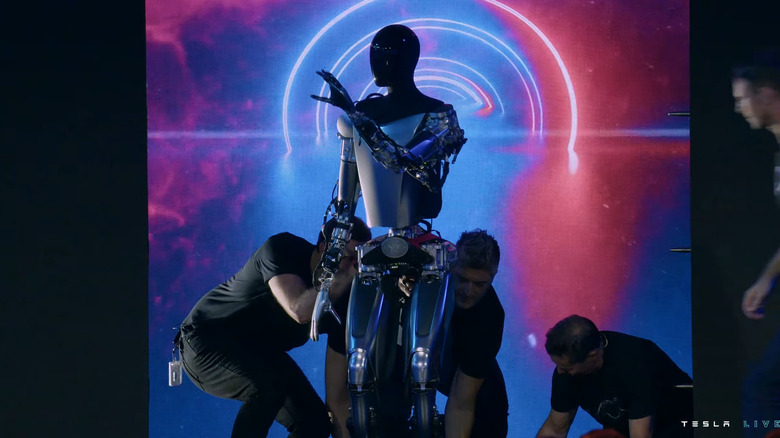
Tesla's working Optimus prototype robot wasn't the only surprise Elon Musk had at Tesla AI Day 2022. The outspoken billionaire sparked no shortage of jokes last year, when he announced he wanted the car company to launch a humanoid robot commercially. Then, it was a person wearing a stretchy suit and dancing; today, it's a real robot.
The first Tesla Optimus prototype was the handiwork of six months development, the automaker's team says. It doesn't quite match up to the promises Musk made in 2021, but it's able to support itself, walk around, and wave. It's also built around Tesla's own self-driving computer.
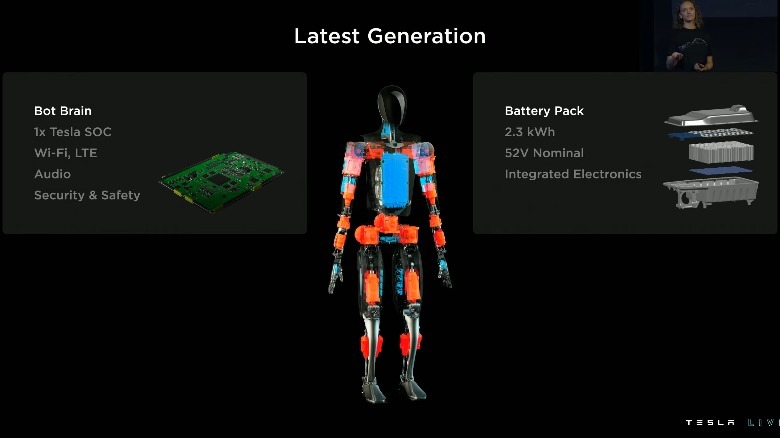
That's usually found inside Tesla cars, where it's responsible for Autopilot. In fact, Tesla is using the same learning processes for the Optimus robot, only instead of tracking other vehicles, pedestrians, and cyclists, it's identifying what it might want to pick up or otherwise manipulate in a factory or office situation.
A far more production-friendly robot
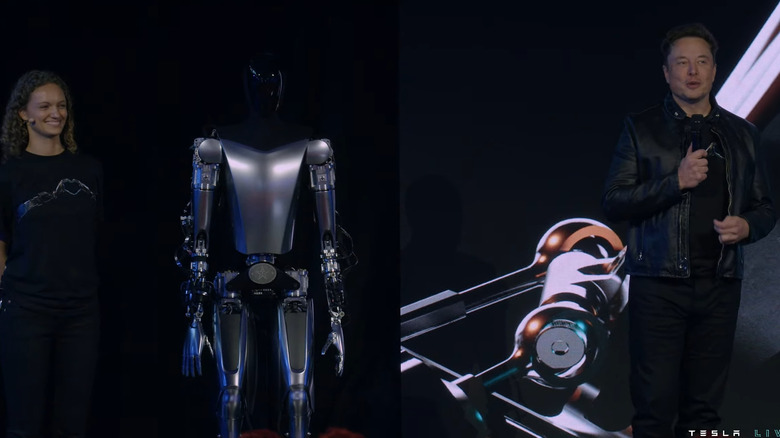
Musk then brought out a much more recent prototype of Optimus. In fact, it's the first version of the robot that Musk hopes to launch commercially. It's capable of moving all of its fingers independently, with opposable thumbs on both hands with two degrees of feedback. Sensors are inside the hands, controlled by a computer actually built into the hand itself.
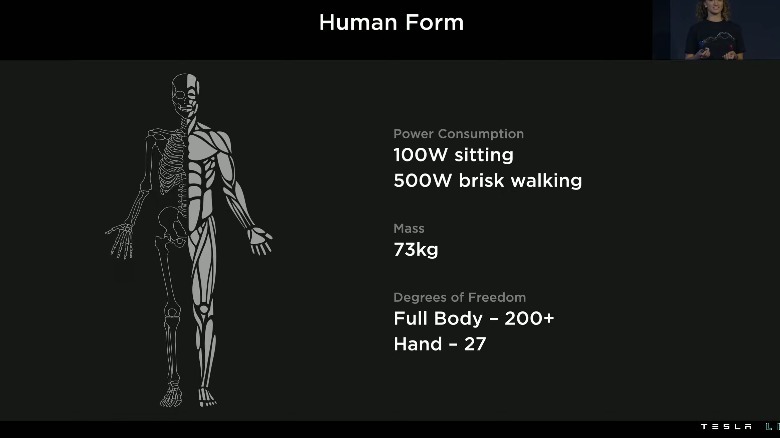
That means the hands can keep track of where they are in space — known as proprioception — as well as what they're holding. The central computer, meanwhile, is a Tesla-designed SoC with WiFi and LTE for permanent connection. The battery, too, is Tesla-developed, a 2.4 kWh battery pack that's built into the chest of Optimus.
It's expected to last for a full day's work, though what exactly that will comprise is unclear at this stage. "There's still a lot of work to improve Optimus," Musk concedes, "and refine it."
Priced less than a car
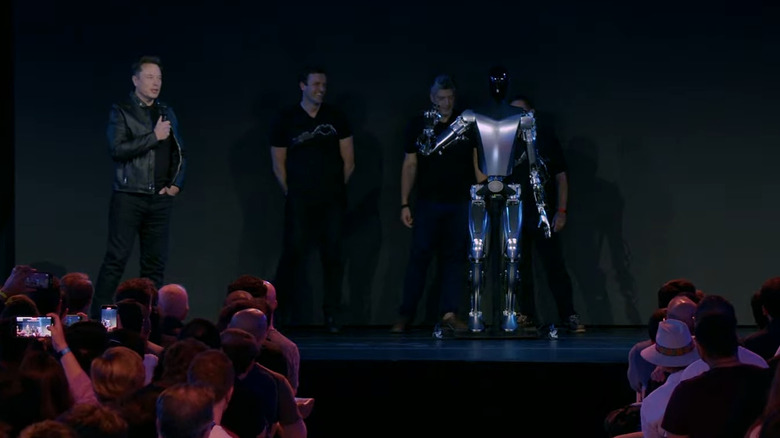
Still, the Tesla CEO is gung-ho about the potential here. "Our goal is to make a useful humanoid robot as soon as possible," Musk said. "We've also designed it with the same discipline as we design the car ... so that it's possible to produce the robot at high volume and low cost, with high reliability."
To achieve that, Tesla is borrowing strategies and technology from its automotive divisions. The knee joint, for example, is inspired by human knees. However Tesla is also using crash tests similar to those its cars go through, to make sure that any damage to the robot from a fall will only be superficial.
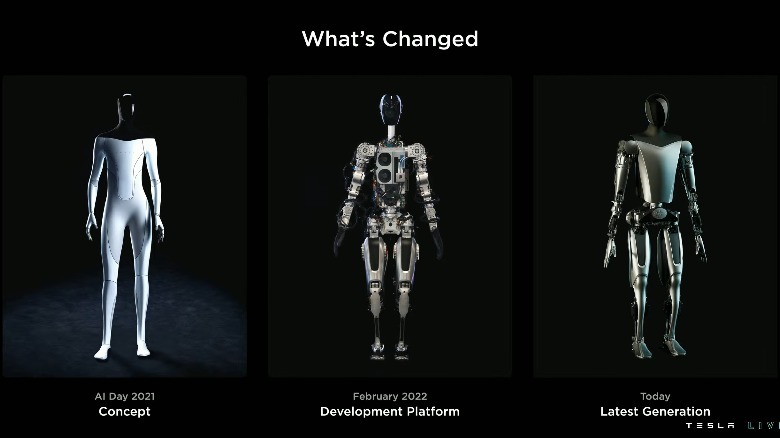
The biggest surprise — and perhaps the largest challenge Tesla faces — is pricing, where Musk is being highly ambitious. "It's expected to cost much less than a car," the CEO said of the production Optimus. "It's probably less than $20,000, that would be my guess." That's considerably cheaper than even Tesla's cheapest car.
It's unclear when, exactly, sales might be able to begin, and clearly Optimus is still in development with months or years of work ahead, the robot team admits. Nonetheless, Musk is already aware that there could be skepticism — or outright hostility — to what is in the pipeline here. "It really is a fundamental transformation of civilization as we know it," he acknowledged. "Obviously we want to make sure that transformation is a positive one, and safe."
The Transformation Of Tesla From 2003 To 2022
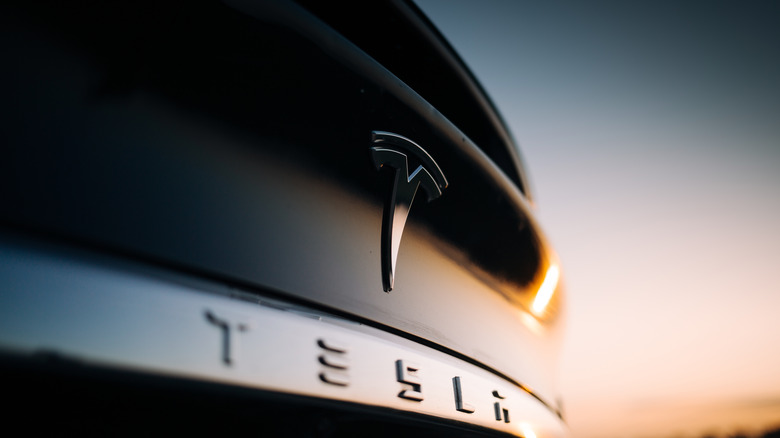
With climate change presenting itself as the most pressing crisis facing humanity, the switch to more environmentally friendly practices and away from fossil fuels has never been more important. At the cusp of this change is the adoption of electric vehicles, which over their lifetime are kinder to the environment than fossil fuel-powered alternatives.
Heading up the revolution in electric vehicles is Tesla and its ever-controversial CEO Elon Musk. Tesla is on the verge of becoming to the electric car what Hoover became to the vacuum cleaner.
The story of how the Silicon Valley-based start-up rose to the top of the electric car mountain is as intriguing as any in the history of engineering and begins long before its 2003 formation. This is a weaving narrative involving business disputes, Twitter controversies, and even issues with the government. Through all this Tesla will go from an electric sports car to offering family-friendly options, the integration of solar power, and the expansion of a product range to rule the roads.
1800s - 1900s: Electric vechiles before Tesla
Tesla wasn't the first to innovate in the field of electric vehicles. According to the United States Department of Energy, the first small-scale electric cars were developed in Hungary, the Netherlands, and the U.S. during the early nineteenth century. The development of an electric carriage to traverse roads, still dominated at the time by horses and buggies, had been made possible by the invention of the electric motor and the battery.
British inventor Robert Anderson would create a rudimentary electric carriage in the mid-1800s followed by practical electric cars developed by fellow English inventors and counterparts across the channel in France.
In the U.S. a Des Moines chemist, William Morrison, would build a six-passenger electric wagon with a top speed of around 14 miles per hour in 1890.
Morrison's wagon inspired an interest in electric vehicles that would see such machines developed by various manufacturers. This interest reached its height by 1900, at which point electric carriages accounted for a third of all vehicles on the road according to the Department of Energy.
Though supported by luminaries like Thomas Eddison and Henry Ford, it was Ford's mass-produced Model T introduced in 1908 that would deal electric vehicle technology a killer blow by 1935, the Department of Energy adds.
As well as being significantly cheaper, $650 compared to $1,750, gasoline cars faired better on the open road and when traveling between cities. The discovery of crude oil in Texas brought the price of gas down and filling stations emerged across the U.S., even in some rural areas that still didn't have electricity.
2003: The founding of Tesla
Aside from some minor surges in interest in electric cars during the 1970s and 1990s, sparked by gasoline shortages and government policies such as the 1990 Clean Air Act Amendment and the 1992 Energy Policy Act, the period between 1935 and 1997 was a dark age for the electric car, according to the Department of Energy.
The end of the 20th century marked the development of the hybrid-electric Toyota Prius, which would release first in Japan in 1997, going worldwide three years later in 2000. The Prius owed much of its success to concerns regarding carbon pollution and profile-raising interest from many celebrities at the time.
Tesla was formed in 2003 by American entrepreneurs Martin Eberhard and Marc Tarpenning, following in the footsteps of the Prius but hoping to expand on its success.
The Silicon Valley start-up originally operated under the name Tesla Motors after Serbian American inventor Nikola Tesla, and the company's aim, according to its website, was: "to prove that people didn't need to compromise to drive electric — that electric vehicles can be better, quicker and more fun to drive than gasoline cars."
2004: Elon Musk becomes chairman
One of the earliest supporters of Tesla Motors was South African-born entrepreneur and PayPal co-founder Elon Musk. In 2002, the forward-thinking Musk had founded Space Exploration Technologies (SpaceX) with the aim of creating more affordable rockets, but his relationship with the electric car would begin to formalize in the year following this.
In 2003, Musk — who had long been interested in electric cars and sustainability, took a test drive in the TZero electric car built by Californian company AC Propulsion, which inspired him to become involved in electric car development.
In 2020 Musk told the story of his test drive to Third Row Tesla Podcast: "It didn't have doors or a roof so clearly you need to add those things or any safety systems and it was very unreliable because it was just like a sort of a proof of concept, basically."
Yet his experience with the TZero, as crude as it was, was enough to persuade Musk to invest $30 million into Tesla. In 2004, the SpaceX founder would go on to serve as chairman of the company.
2004: Musk's masterplan
Writing in 2016, Elon Musk outlined what had beed his "Master Plan" for the early stages of Tesla. The Tesla CEO wrote: "It wasn't all that complicated and basically consisted of:
- Create a low volume car, which would necessarily be expensive
- Use that money to develop a medium volume car at a lower price
- Use that money to create an affordable, high volume car
And...
4. Provide solar power. No kidding, this has literally been on our website for 10 years.
"The reason we had to start off with step 1 was that it was all I could afford to do with what I made from PayPal. I thought our chances of success were so low that I didn't want to risk anyone's funds in the beginning but my own. The list of successful car company startups is short."
Musk added that "starting a car company is idiotic and an electric car company is idiocy squared."
Yet, in 2006, three years after its founding, Tesla Motors would change the face of electric cars forever when it unveiled the prototype of a luxury electric sports car that could travel over 200 miles on a single charge.
2008 The Completely Electric Roadster
Production began on Tesla's first electric commercial vehicle, the Tesla Roadster, in 2008. In tests, it achieved 245 miles on a single charge of its lithium-ion battery, something that had not been previously achieved.
The two-seat sports car with a three-phase four-pole electric induction motor coupled to a single-speed Borg-Warner transaxle producing maximum torque at 14,000 rpm and reached 125 miles per hour.
The Roadster's onboard computer allowed the driver to select among five drive types: Maximum Performance, Maximum Range, Standard, Storage, and Valet. It also managed the recharge system of the car's lithium-ion batteries with a full charge taking 3.5 hours, and two hours to reach 80%. Users could charge the battery from a standard domestic outlet in 10 to 15 hours.
In 2010 Tesla announced the commencement of regular production of the 2008 roadster and the introduction of a five-passenger sports sedan. It wrote, "With a 0 to 60 mph acceleration of 3.9 seconds, a 13,000 rpm redline, and the fastest top gear acceleration of any production car tested by Car & Driver magazine in 2007, combined with an EPA rating of 135 MPG equivalent, the Tesla Roadster is unique in providing supercar performance at twice the energy efficiency of the best hybrids."
In 2010 Tesla opened its Fremont Factory in California in a building originally constructed by General Motors. In 2021 the factory produced 9,000 cars per week, which Licarco reports made it the most productive car factory in the U.S.
2007-2008: original founders leave as Musk takes over
In late 2007, Martin Eberhard resigned as CEO and president of technology at Tesla and joined its advisory board. A year later he left the company altogether but remained a share-holder.
Also in 2008, Marc Tarpenning left the role of vice president of electrical engineering and supervision of the development of the software systems and electric systems for the Roadster, and also departed Tesla.
Wired reported that Eberhard went on to sue Elon Musk, accusing him of taking control of Tesla and rewriting history to take the credit for developing the pioneering electric Roadster. The lawsuit was settled in 2009 and despite the previous bad blood, Eberhard told CNBC in 2021 that he still rooted for Tesla.
Ever the engineer, Eberhard is currently working on making batteries for electric cars more affordable without compromising on safety or performance.
Also speaking to CNBC in 2021, Tarpenning said he has no regrets in leaving Tesla as the company was working on its successor to the roadster. He said: "The whole thing was wonderful from the beginning to the end. It was, you know, the worst and the best. And it's worked out great."
2012: The Roadster Replaced
Production on the Roadster ceased in 2012 when Tesla decided to focus instead on its Model S sedan. One of the most significant improvements the Model S had over the Roadster was the battery, with an estimated range of around 300 miles.
These batteries came in three options ranging in performance. The highest-performance battery allowed the Model S to accelerate from 0 to 60 in just over four seconds and allowed for a top speed of 130 miles per hour. Another change was the shift in the battery's location from at the back of the car as in the Roadster, to under the floor of the Model S.
This was more than merely cosmetic, however, as it gave the new model a lower center of gravity and thus improved handling. The change would go on to be implemented in future Tesla models and become one of the most popular features.
2015: Tesla Crosses Over
In 2010, Tesla received a $465 million loan from the Department of Energy's Loan Programs Office to establish a manufacturing facility in California. Paying this loan in full nine years early, Tesla would go on to become the largest auto-industry employer in California.
The introduction of the "crossover" Model X, a Tesla sports vehicle (SUV) on a car chassis crossover, came in 2015. The seven-seater vehicle had a battery that allowed it to travel about 340 miles on a single charge.
This wouldn't be Tesla's only crossover in 2015, as that would also be the year that the company expanded into solar energy, unveiling a line of batteries that stored solar energy for both domestic and business use.
In addition to this, the following year, Tesla also bought out solar panel company SolarCity allowing Tesla to offer rooftop solar panels, a solar roof with energy-generating tiles, and a large battery called the Powerwall designed to capture and store solar energy for use when the sun was not shining or as a backup in case of a power outage.
To reflect the expansion beyond cars Tesla changed its company name from Tesla Motors to Tesla Inc in 2017.
2017: Making electric cars more accessible
The Roadster's price tag of $109,000 made it a luxury item, and the demand for a less expensive electric car would lead to the production of a four-door sedan, the Model 3, in 2017.
The car, described by Tesla as a low-priced, high-volume electric vehicle, featured an all-glass roof and controls on a 38-centimeter central touchscreen panel capable of traveling up to 350 miles on a single charge.
Not only would the Model 3 become Tesa's best-selling model, but it would also go on to become the best-selling electric car of all time, accelerating past the Nissan Leaf, selling over half a million units in 2021 alone.
The integration of solar power into the Tesla portfolio and the development of both an expensive low-volume car and a high-volume less expensive model meant that many of the prongs in Elon Musk's initial master plan were in place. But trouble lay ahead for the innovator and his company.
2018: Telsa and Musk hit bumpy roads
It was some unguarded tweets that landed Elon Musk and Tesla in hot water with the U.S. Securities and Exchange Commission (SEC) in 2018.
The SEC said that in tweets sent on August 7, 2018, Musk stated he could take Tesla private at $420 per share — substantially higher than its trading price at the time — and that funding for the transaction had been secured, with the only remaining uncertainty being a shareholder vote. The SEC alleged that Musk knew that the potential transaction was uncertain and subject to numerous contingencies and that the CEO's misleading tweets caused Tesla's stock price to jump by over six percent on August 7, leading to significant market disruption.
The SEC charged Tesla with failing to have the required disclosure controls and procedures relating to Musk's tweets, a charge that the company agreed to settle. Musk had to step down as chairman of Tesla but was allowed to remain as CEO. Both Tesla and Musk were fined $20 million USD.
Electric cars today
The success of Tesla inspired several large car manufacturers to intensify the development and production of electric cars.
In late 2010, Chevrolet introduced the Chevy Bolt, the first commercially available plug-in hybrid with a gasoline engine that "tags in" for its electric battery when depleted of power. Around the same time, Nissan introduced the aforementioned Nissan Leaf, an all-electric vehicle powered by an electric motor alone.
In June 2021, Pew Research Center revealed that while demand for electric cars in the U.S. is growing slower than in other countries, 39% of U.S. adults said that they were likely to consider such a vehicle in the future.
The research center also revealed that in 2020 almost 1.8 million electric vehicles were registered in the U.S., three times the number registered in 2017. The fastest-growing group in this section of the market is all-electric cars which went up from 300,000 units in 2016 to 1.1 million units in 2020.
As electric vehicles have become more popular, the Energy Department has invested $115 million into a nationwide charging infrastructure, including 18,000 residential, commercial, and public chargers throughout the U.S.
This was bolstered by the efforts of private businesses to introduce more than 20,000 charging outlets to public electric vehicle chargers in more than 8,000 different locations across the country.
These join Tesla's own Supercharger stations in the U.S. and Europe designed to charge batteries rapidly which come at no added cost for Tesla owners.
Telsa's current batch of electric vehicles
In 2022, Tesla introduced the Model Y, a smaller and less expensive alternative to the Model X. Sales of the electric car would soon approach those of the Model 3, with over 410,000 units sold in 2021 alone.
In California during 2021, sales of the seven-seater Model Y would actually leapfrog sales of the Model 3, shifting over 60,000 units compared to 53,572 units in the state according to California New Car Dealers Association.
But, Tesla's current strategy expands beyond commercial vehicles Elon Musk revealed in his "Master Plan, Part Deux" blog post in July 2016.
Musk wrote: "In addition to consumer vehicles, there are two other types of electric vehicle needed: heavy-duty trucks and high passenger-density urban transport. Both are in the early stages of development at Tesla and should be ready for unveiling next year.
"We believe the Tesla Semi will deliver a substantial reduction in the cost of cargo transport, while increasing safety and making it really fun to operate."
In November 2017 the company unveiled the Tesla Semi, a heavy-duty all-electric truck program spearheaded by former Model S Program Director and VP of Vehicle Engineering, Jerome Guillen.
The company describes the Tesla Semi as "the safest, most comfortable truck ever." It expects the truck, which possesses four independent motors providing maximum power and acceleration and low energy costs per mile, to release in 2022.
The future of electric cars and Tesla
The future of Tesla's electric cars includes a nod to the company's past, with Tesla intending to once again put the name "Roadster" back on the electric car map.
Tesla says that the new model Roadster, which was initially set to debut in 2021, can go from 0 to 60 mph in just 1.9 seconds. It adds that the second-generation Roadster has a top speed of over 250 mph and can travel 620 miles on a single charge.
The future of Tesla won't only be marked by speed, however.
In addition to the regenerated Roadster, Tesla also plans to complete the development of a pickup truck called the Cybertruck at some point in 2022.
Tesla says that the Cybertruck will mark a new class of strength, speed, and versatility which is only possible with an all-electric design. The company also says that the truck will be able to accelerate from 0 to 60 mph in just 2.9 seconds, with a range of 500 miles.
Tesla currently owns six factories, including Freemont which is still churning out Model S, Model X, Model Y, and Model 3 cars. In 2016 the company opened its first Gigafactory in Reno Nevada, followed by more in Buffalo, New York, and Shanghai, China.
The latter of these factories has been producing electric cars for China for almost two years, while the former locations are limited to the production of lithium-ion batteries and solar panels.
Recommend
About Joyk
Aggregate valuable and interesting links.
Joyk means Joy of geeK